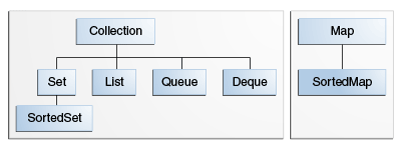The core collection interfaces encapsulate different types of collections, which are shown in the figure below. These interfaces allow collections to be manipulated independently of the details of their representation. Core collection interfaces are the foundation of the Java Collections Framework. As you can see in the following figure, the core collection interfaces form a hierarchy.

The following list describes the core collection interfaces:
Collection— the root of the collection hierarchy. A collection represents a group of objects known as its elements. TheCollectioninterface is the least common denominator that all collections implement and is used to pass collections around and to manipulate them when maximum generality is desired. Some types of collections allow duplicate elements, and others do not. Some are ordered and others are unordered. The Java platform doesn't provide any direct implementations of this interface but provides implementations of more specific subinterfaces, such asSetandList. Also see The Collection Interface section.Set— a collection that cannot contain duplicate elements. This interface models the mathematical set abstraction and is used to represent sets, such as the cards comprising a poker hand, the courses making up a student's schedule, or the processes running on a machine. See also The Set Interface section.List— an ordered collection (sometimes called a sequence).Lists can contain duplicate elements. The user of aListgenerally has precise control over where in the list each element is inserted and can access elements by their integer index (position). If you've usedVector, you're familiar with the general flavor ofList. Also see The List Interface section.Queue— a collection used to hold multiple elements prior to processing. Besides basicCollectionoperations, aQueueprovides additional insertion, extraction, and inspection operations.Queues typically, but do not necessarily, order elements in a FIFO (first-in, first-out) manner. Among the exceptions are priority queues, which order elements according to a supplied comparator or the elements' natural ordering. Whatever the ordering used, the head of the queue is the element that would be removed by a call toremoveorpoll. In a FIFO queue, all new elements are inserted at the tail of the queue. Other kinds of queues may use different placement rules. EveryQueueimplementation must specify its ordering properties. Also see The Queue Interface section.Deque— a collection used to hold multiple elements prior to processing. Besides basicCollectionoperations, aDequeprovides additional insertion, extraction, and inspection operations.Deques can be used both as FIFO (first-in, first-out) and LIFO (last-in, first-out). In a deque all new elements can be inserted, retrieved and removed at both ends. Also seeThe Deque Interface section.Map— an object that maps keys to values. AMapcannot contain duplicate keys; each key can map to at most one value. If you've usedHashtable, you're already familiar with the basics ofMap. Also see The Map Interface section.
The last two core collection interfaces are merely sorted versions of
Set and Map:SortedSet— aSetthat maintains its elements in ascending order. Several additional operations are provided to take advantage of the ordering. Sorted sets are used for naturally ordered sets, such as word lists and membership rolls. Also see The SortedSet Interface section.SortedMap— aMapthat maintains its mappings in ascending key order. This is theMapanalog ofSortedSet. Sorted maps are used for naturally ordered collections of key/value pairs, such as dictionaries and telephone directories. Also see The SortedMap Interface section.
To understand how the sorted interfaces maintain the order of their elements, see the Object Ordering section.
No comments:
Post a Comment